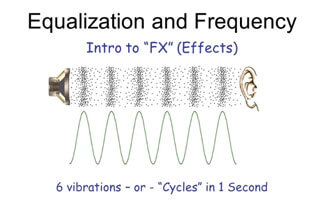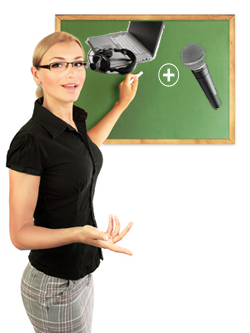 Equalization, or “EQ” for short, is one thing that can really differentiate a beginner mix from an expert one. Part of the reason for this is that it SEEMS like such a difficult topic to wrap your head around if you are not an engineer or audio techie.
Equalization, or “EQ” for short, is one thing that can really differentiate a beginner mix from an expert one. Part of the reason for this is that it SEEMS like such a difficult topic to wrap your head around if you are not an engineer or audio techie.
But part of the reason for that is the same old issue of making fairly simple concepts appear overly complicated.
Folks with experience and some basic EQ knowledge understand exactly what they are trying to do before they reach for those EQ controls. When I first started, I didn’t have a specific objective in mind (like, say, stop the low guitar notes from covering up the bass guitar notes). I would just use a preset and if it sounded decent, I’d use it. No bueno. EQ is a powerful tool and can mess things up if you don’t know some things.
But those things are not that difficult. For a quick primer on what EQ is, see my video (an excerpt from The Newbies Guide To Audio Recording Awesomeness) here:
That should help a lot. Then you can get some great tips from Graham over at Recording Revolution at the following link:
Click here to read more…
Home Recording Equipment
Home Studio Defined
Since recording in such a studio is restrictively costly for most performers, you might need to consider more moderate choices for the present — like setting up a home studio. Click here to read more…
Review For Waves’ Abbey Road Reverb Plates
Abbey Road Reverb Plates, Waves’ most recent offering, concentrates on a genuine exemplary of vintage reverb. Click this to read more…
IK Multimedia – VocaLive For iPhone and iPad
The primary expert vocal processor for live execution and multi-track recording on iPhone/iPad.
VocaLive gives you a chance to make astounding vocal impacts by tying up to 4 effects processors into a single effects chain, much the same as you would in the studio. Click here to read more…
Easy Home Recording Basics – The PC Home Recording Studio
 Home recording can be an easy, entertaining and rewarding pursuit. You can create professional audio for your music, podcasts, videos, voice-overs, etc. Only a few years back, studio quality recordings were only possible in expensive studios with thousands of clams worth of equipment.
Home recording can be an easy, entertaining and rewarding pursuit. You can create professional audio for your music, podcasts, videos, voice-overs, etc. Only a few years back, studio quality recordings were only possible in expensive studios with thousands of clams worth of equipment.
But now, anyone can do it right on your home computer. There are some basics to be absorbed, though. First what do you need? You can spend a ton of cash on gear that you don’t really need. I recommend that if you’re just starting out, you don’t buy any of it. The least expensive and easiest way to get studio-quality recordings is with a computer that was made in the past…say…10 years (this being 2010). This will be your PC recording studio.
You’ll also need a microphone (or “mic” for short). If you’re just starting out, you can learn all the techniques for creating pro-audio with just a plastic PC mic. I poo you not! Pretty soon you’ll want better sound, and a usb mic for about 49 bucks (like the Samson Q1U) will be a huge jump in quality. Over time, you can upgrade incrementally…if you need to.
Then you want to take a look at software. I like to use multi-track recording program (sometimes called a digital audio workstation or DAW) and a sound editing program. But most DAWs will allow you to do everything you need without having additional software just for editing (an on-going topic of debate;)). Anyway, you’ll be able to find software for free that compares well in quality with the big and dear brand names. I recommend trying Audacity, which coincidentally, is BOTH a multi-track recorder and sound editor in one. It’s absolutely free and can be downloaded from the open source playground Sourceforge. Personally, I use Reaper.
After you have your software, do some recording save it as mp3 or wav format, then put your earphones on and turn the volume up. Listen for hisses and clicks in the final version, and notice how far you have got to turn it to get it loud. If there are plenty of hisses and clicks, this is sometimes known as a ‘dirty’ or ‘noisy’ recording. Hear me now and believe me later…NOISE IS PUBLIC ENEMY #1! And it is always with us. Many programs will edit out the noise, but when they do they can also adversely affect the over-all quality. Why? Because in editing out the noise, it also filters out part of the signal…the stuff you WANT! The less noise you have to deal with, the better noise-reduction programs work. I know that sounds obvious, but look at it this way. Noise reduction can completely eliminate soft, low-volume noise without leaving any audible yuckiness. But as the percentage of noise in the audio goes up, the yuckiness that is left behind gets worse and worse.
That is the reason why it is so vital to try and get as clean a recording as possible the 1st time around! Prevention is the key. See my article on fighting noise (https://www.homebrewaudio.com/fastest-way-to-improve-audio-on-pc-recording-studio)for more information on that. One reason I recommend starting out with a $5.00 PC mic is that by learning to get the least amount of noise from that thing, you’ll know how to get the best out of every mic you ever use after that. For now, you can help yourself out by getting the mic as close to the sound source as possible, and trying to record in as quiet a space as possible.
Once you have recorded your audio, listen to it in head phones, ear-buds, or on speakers. Actually, do all 3 and notice the difference. After that just save the audio as either an mp3 or wav file (there are lots of sound formats, but those 2 are just the most common). Use the mp3 for audio you want to put on the web. Use the wav for burning CDs on your computer, or for adding audio to video, etc.
Learn much, much more in the articles and tutorials here at Home Brew Audio. Teaching audio recording in a way that makes sense to everyone is our goal.